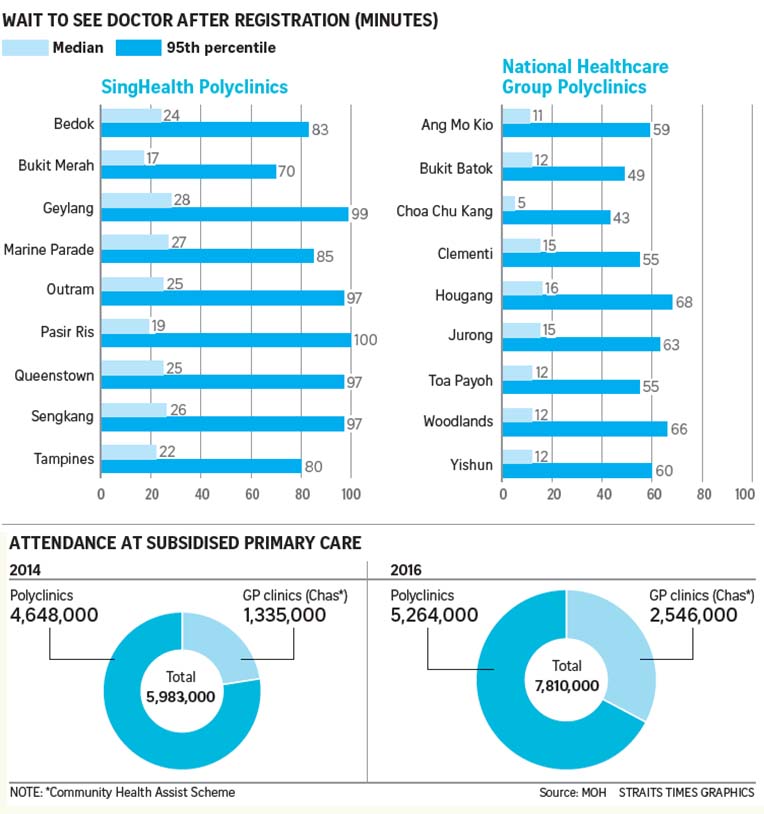Recent figures released by MOH show that waiting times to see polyclinic doctors have gone up significantly this year. It was reported that the wait is longer at the nine SingHealth polyclinics, with a median wait time of 17 to 28 mins.
Waiting times to see a polyclinic doctor have gone up significantly this year, the latest
(MOH) numbers show.
Figures for March showed that on a national level, the median wait to see a doctor was 18 minutes. This is close to 30 per cent longer than median waiting times of 14 minutes for the whole of last year, as well as 2015. Median waiting times had otherwise been trending downwards from 18 minutes in 2014.
However, the waits are not uniform.
Depending on the polyclinic, patients could either have a very quick turnaround time, or might have to wait more than three hours to register, see a doctor and get medicine.
The waits are longer at the nine SingHealth polyclinics, with a median wait of 17 to 28 minutes, against five to 16 minutes at National Healthcare Group Polyclinics (NHGP).
One in 20 patients at SingHealth waited more than 70 to 100 minutes, while those at NHGP waited 43 to 68 minutes to see a doctor.
These waits exclude the time needed to register and get medicine or to fix the next appointment.
Mr M. Thufiq’s four-year-old daughter had to wait 2 1/2 hours to see a doctor at Sengkang Polyclinic, which falls under SingHealth. The 33-year-old civil servant said this was the norm, adding: “I just have to bear with it.”
Another patient there, Ms Nicole Lee, 24, waited 11/2 hours to see the doctor. The retail manager said in Mandarin: “I can’t avoid going (to a polyclinic) because my company allows me to make medical claims only from polyclinics. Waits are unavoidable because it’s a government clinic.”
In March, half the people at Sengkang Polyclinic took less than eight minutes to register, while half saw a doctor within 26 minutes of registering. They were likely to be patients with appointments.
However, 5 per cent took more than 25 minutes to register, and 5 per cent waited more than 1 1/2 hours after that to see a doctor.
The SingHealth Polyclinics are upfront about the long wait. Patients can check the estimated waiting time online – and it can be more than three hours.
In contrast, at Choa Chu Kang Polyclinic, which is under NHGP, half the patients were registered within two minutes and saw the doctor within five minutes.
At the 95th percentile, registration took 17 minutes and the wait to see the doctor was 43 minutes.
When asked why waits at its polyclinics are consistently longer than at NHGP, Ms Haslina Abdul Majid, assistant director of operations at SingHealth Polyclinics, only said: “Patients who make appointments experience shorter waiting times than those who walk in.”
Many of the patients The Straits Times spoke to were also not aware of the Community Health Assist Scheme (Chas) scheme, launched in 2012, where about half the population – families with a per capita income of $1,800 or less – can get subsidised care at private general practice (GP) clinics.
Nevertheless, Chas paid for more than 2.5 million visits to GP clinics last year. Of these, 675,000 were for the treatment of chronic ailments.
An MOH spokesman said: “To alleviate patient load in polyclinics and help meet chronic care demand, MOH will continue its efforts to tap the larger existing GP sector to increase private primary care capacity.”
In spite of Chas taking on a significant number of subsidised patients, the numbers at polyclinics continue to rise – from 4.6 million visits in 2014 to 5.3 million visits last year.
To cope with the higher demand, polyclinics have been adding more staff, with manpower going up from 2,400 in 2014 to 2,700 last year.
To ease the situation further, two new polyclinics will open this year, in Jurong and Punggol.
The redeveloped Bedok Polyclinic, which will be housed at HeartBeat@Bedok, will also open later this year.

